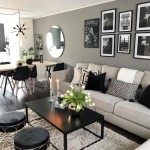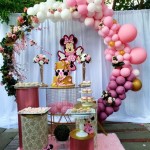How To Decorate Your Living Room With A Sectional
A sectional sofa presents a unique opportunity to transform a living room into a comfortable and stylish space. Its inherent size demands careful consideration of layout, color palette, and overall design to ensure a cohesive and visually appealing result. This article provides a comprehensive guide to decorating a living room centered around a sectional sofa, outlining key considerations and practical advice for achieving a desired aesthetic.
Assess the Living Room's Dimensions and Layout
The first step in decorating with a sectional involves a meticulous evaluation of the available space. Accurate measurements of the living room's length, width, and height are crucial. These dimensions provide a framework for determining the appropriate size and configuration of the sectional. Consider the existing architectural features, such as windows, doors, fireplaces, and built-in shelves. Note the location of electrical outlets and any structural elements that might impede furniture placement.
The natural flow of foot traffic within the room should also be carefully observed. Ensure that the sectional is positioned in a way that doesn't obstruct pathways. Think about how the room will be used. Will it primarily serve as a space for entertaining, relaxing, or a combination of both? This assessment will help determine whether an oversized sectional or a smaller, more modular configuration is the most suitable choice. Furthermore, creating a floor plan, either using graph paper or a digital design tool, can visually represent the room's dimensions and allow for experimentation with different sectional arrangements before making a final decision.
Determine the Sectional's Configuration and Style
Sectionals come in a wide array of configurations and styles. Understanding the available options is essential for selecting the best fit for the living room. Common configurations include L-shaped sectionals (right or left-facing), U-shaped sectionals, and modular sectionals. L-shaped sectionals are versatile and suitable for various room sizes, while U-shaped options are typically better suited for larger spaces and encourage a more intimate seating arrangement. Modular sectionals offer maximum flexibility, allowing for rearrangement and adaptation to changing needs.
In addition to configuration, the style of the sectional should harmonize with the overall aesthetic desired for the living room. Consider factors such as the sofa's arm style (e.g., track arms, rolled arms, or pillow arms), back style (e.g., low backs, high backs, or tufted backs), and leg style (e.g., exposed legs or a skirted base). The choice of fabric is equally important. Durable, easy-to-clean fabrics such as performance fabrics, microfiber, or leather are excellent choices for high-traffic areas. Other factors like the sofa's color, pattern, and texture should be based on the room’s overall color scheme.
Select a Complementary Color Palette
The color palette of the living room should work in harmony with the sectional's upholstery. The sectional can either serve as the focal point, with the rest of the room's colors complementing it, or it can blend seamlessly with the existing color scheme. Neutral-colored sectionals, such as gray, beige, or white, offer the most versatility and can be paired with a wide range of accent colors. Bold or patterned sectionals, on the other hand, provide a more defined starting point for the color palette. Consider the lighting conditions in the room. Natural light can affect colors, and artificial lighting can add warmth or coolness.
Introduce color through accent pillows, throws, area rugs, and wall art. Aim for a balance of colors, textures, and patterns to create visual interest. Consider the use of a color wheel to identify complementary or analogous color schemes. For example, if the sectional is blue, consider accenting with shades of gray, white, and touches of yellow or orange for a visually dynamic combination. Consistency in the color palette contributes to a sense of cohesion and elegance throughout the living room.
Choose Appropriate Supporting Furniture
The furniture surrounding the sectional plays a critical role in defining the room's functionality and aesthetic. A coffee table is a necessity, providing a surface for drinks, snacks, and decorative items. Consider the size and shape of the coffee table in relation to the sectional. A general guideline is to find a coffee table that is approximately half to two-thirds the length of the sofa and approximately 18 inches away from the sofa. Side tables or end tables can be positioned on either side of the sectional to provide additional surfaces for lamps, books, or other personal items. The height of the tables should be in proportion to the sectional's arm height.
Additional seating options, such as armchairs, ottomans, or benches, can enhance the room's capacity for entertaining and provide a more inviting atmosphere. A media console or entertainment unit is essential if the living room houses a television and related equipment. Bookcases, shelving units, or storage cabinets can provide space for displaying decorative items and storing personal belongings. The choice of supporting furniture should be consistent with the style and scale of the sectional sofa, as well as the overall aesthetic of the living room. Avoid overcrowding the space; a balanced arrangement, with sufficient open areas, contributes to a more relaxed and functional atmosphere.
Incorporate Textiles and Accessories
Textiles and accessories are instrumental in personalizing the living room and adding layers of warmth and sophistication. Accent pillows can introduce color, pattern, and texture, creating visual interest and enhancing the comfort of the sectional. Throws can be draped over the sectional to add warmth, texture, and visual appeal. Area rugs define the seating area and add softness underfoot while anchoring the furniture. Select a rug that is appropriately sized for the space and incorporates the colors from the room's palette.
Wall art, mirrors, and decorative objects can be used to express personal style and add character to the space. Consider the scale and placement of wall art to ensure that it complements the sectional and other furnishings. Lamps provide both task lighting and ambient lighting, creating a cozy and inviting atmosphere. Choose lamps with shades that complement the color palette of the room. Greenery, such as plants or flowers, can add freshness and vitality to the living room. The use of well-chosen textiles and accessories allows for customization, reflecting the occupant’s personality and enhancing the overall aesthetic.

Small Living Room Decor Ideas With A Sectional

Living Room Corner Sectional Taryn Whiteaker Designs
:strip_icc()/CasaWatkingsMCM-0a1d38fc37b947d2a6a245374f14a87a.jpg?strip=all)
20 Gorgeous Sectional Living Room Ideas

Best Design Ideas For Gray Sectional Sofas

Living Room Corner Sectional Taryn Whiteaker Designs

18 Creative Sectional Sofa Ideas For Your Living Room

How To Arrange A Sectional Sofa In Small Room Rst Brands

14 Sectional Living Room Ideas Sugar Cloth

Best Design Ideas For Gray Sectional Sofas

Living Room Corner Sectional Taryn Whiteaker Designs
Related Posts







